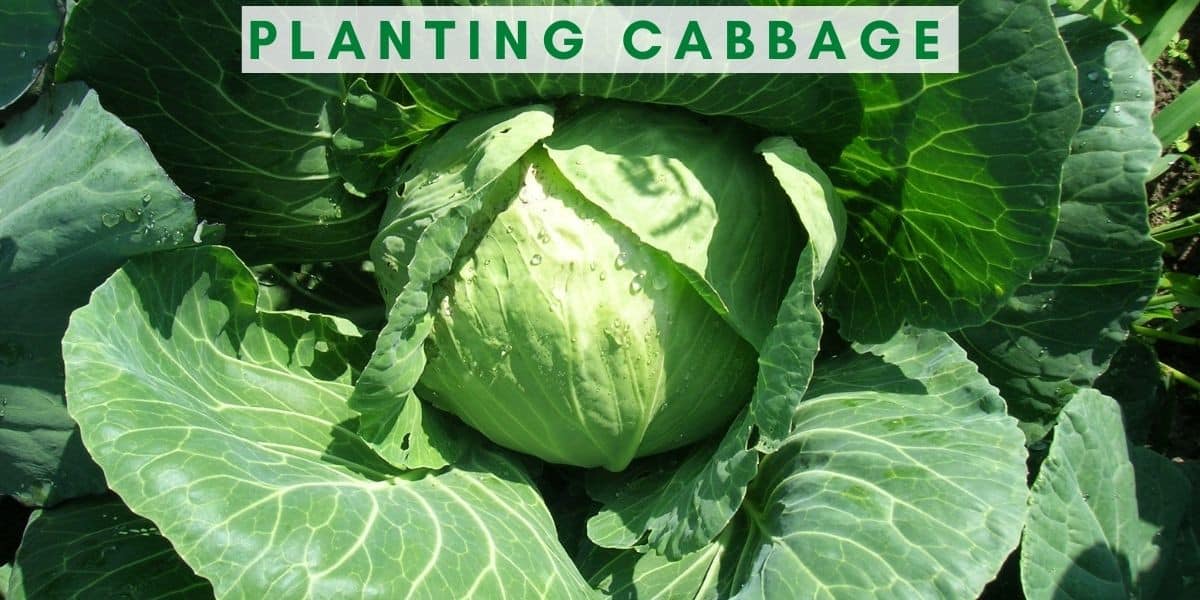There are many Types Of Cabbage and Planting Cabbage is favorite cultivation from old. Cabbage, which is frequently lumped into a similar classification as lettuce due to its comparative appearance, is a piece of the cruciferous vegetable family. Cabbage, which is regularly lumped into a similar classification as lettuce given its comparative appearance, is a piece of the cruciferous vegetable family.
Regardless of its unique supplement content, cabbage is frequently neglected. While it might look a ton like lettuce, it has a place with the Brassica sort of vegetables, which incorporates broccoli, cauliflower, and kale. It arrives in various shapes and shadings, including red, purple, white, and green, and its leaves can be either crinkled or smooth. Let’s know more about planting, harvesting, and the variety of cabbages.
Table Of Content
Overview Of Cabbage
Biological Name
Brassica oleracea
Plant Type
Biennial (typically grown as annual)
Maturity Period
90-120 days
Maturity Size
12 to 18 inches tall and wide
Soil Type
Rich, well-drained
Soil pH
Neutral (above 6.8)
Exposure
Full sun
Hardiness (USDA Zone)
2 to 11
Spacing
40cm- 45cm
Bloom Time
Typically does not flower
Toxity
Non-toxic
Flower Color
Typically does not flower
Growth Rate
95- 150 days
Native Zone
Europe
Maintenance
Give the daylight access: Cabbages need full sun – in any event six to eight hours of direct daylight each day. Water carefully: It’s ideal to water in the first part of the day and at the foundation of the plant (soil level) keeping the foliage dry.
History of cabbage
In the wild, cabbage species are local to the Mediterranean, where wild cole crops are discovered developing along the Mediterranean and Atlantic shorelines of Europe. Cabbages and kale presumably began in Western Europe; cauliflower and broccoli in the Mediterranean area.
In the wild, cabbage species are local to the Mediterranean, where wild cole crops are discovered developing along the Mediterranean and Atlantic banks of Europe. Cabbages and kale presumably began in Western Europe; cauliflower and broccoli in the Mediterranean district.
How to Plant Cabbage
Best Time of Planting Cabbage
In beginning seeds inside, sow ¼ inch 6 to about two months before the previous spring ice.
For a fall gather, direct plant seeds outside (or plant transfers) in mid-to pre-fall. If your region is especially blistering and dry, hold off on planting until pre-fall. Ensure that the young plants don’t dry out in the mid-year sun’s warmth!
Steps of Planting Cabbage
- Before planting the seedlings outside, solidify off the plants throughout seven days.
- Relocate tiny plants outside on an overcast evening 2 to 3 weeks before the previous spring ice date.
- Plant seedlings 12 to 24 inches separated in lines, contingent upon the size of head wanted. The nearer you plant, the more modest the cabbage heads.
Places of Planting Cabbage
Planting Cabbage In Container
Pick a spot for your holder that gets full sun (6-8 hours, out of every day). Spot the holder on your deck, porch, open patio, or carport. Your holder ought to be at any rate 12 inches down and 18 inches wide, with significant waste openings in the base.
- Fill the compartment with premium quality gardening soil. Utilizing your hands or a scoop, burrow an opening for the cabbage as profound as the pot the cabbage came in.
- Fill in the opening around your plant, and press the dirt immovably around the foundation of the plant to eliminate any air pockets.
- Fill in the opening around your plant, and press the dirt solidly to eliminate air pockets.
- Delicately water your plant utilizing a watering can or a hose with a sprinkler spout.
- Feed your plant as indicated by manure name directions.
Planting Cabbage In Raised Beds
- Pick a spot for your raised bed that gets full sun (6-8 hours, out of each day).
- Fill the raised bed with raised bed soil. Utilizing your hands or a scoop, burrow an opening for the cabbage as profound as the pot the cabbage came in.
- Fill in the opening around your plant, and press the dirt solidly around the foundation of the plant to eliminate any air pockets.
- Tenderly water your plant utilizing a watering can or a hose with a sprinkler spout.
- Feed your plant as per compost mark directions.
Planting Cabbage In The Ground
Cooperating, grown-ups, and children should pick a planting spot that gets full sun. Likewise, with any planting, pick a spot away from any covered links, wires, or lines—permit 3 feet on all sides of your planting opening for your cabbage to develop.
- Utilize a spade or digging tool to relax the dirt. At that point, blend in a couple of digging tools of fertilizer to advance the dirt. Make a tiny opening with your hands or a scoop.
- If your cabbage arrives in a biodegradable pot, douse it with water and painstakingly remove the mark. Remove the lower part of the pot and tenderly stimulate the roots to slacken them. At that point, detach the edge of the pot. Spot your cabbage in the opening, pushing down a little to help the roots connect with the dirt. Plant it, so an inch or two of the stem is covered.
- Fill in the opening around your plant, and press the dirt solidly to eliminate air pockets.
- Delicately water your plant utilizing a watering can or a hose with a sprinkler spout. Feed your plant as indicated by compost bundle directions.
Variety Of Cabbage
They’re reasonable, adaptable, and show up in foods from one side of the planet to the other. They can be braised, barbecued, sautéed, or even cured, but we frequently underestimate them, preferring their crunchier cousin over them.
More generally known as green cabbage, the cannonball cabbage is perhaps the most mainstream cabbage assortment. It is so named how its leaves twisted firmly more than each other in a thick, reduced design, with the eventual outcome taking after a cannonball.
- Bok Choy
You may know it as bok choy, bai cai, or pak choi; however, they all genuinely mean precisely the same thing: a dark, verdant vegetable with slim stems that is more suggestive of Swiss chard or spinach than it is a cannonball cabbage.
- Choy Sum
You may know it as choy whole or cai xin, contingent upon your primary language, in which the Cantonese and Mandarin literal interpretation of its name is “heart of the vegetable.” The green veggie seems like kai lan and its Chinese cabbage kin, bok choy, yet can be effectively perceived by the particular yellow blossoms it bears.
- Napa Cabbage
Oval fit with frilly, yellow-green leaves, this cabbage assortment is better and milder than different assortments and is broadly utilized in East Asian food.
Harvesting Cabbage
Where to Harvest Cabbage
Cabbage is a substantial feeder; it rapidly depletes the dirt of required supplements.
Set up the dirt ahead of time by blending in matured excrement as well as manure.
The soil ought to be well-depleting: establishes that remain in water cause heads to part or decay.
Store and Harvest Cabbages
The heads of cabbage require around 7 to two months to arrive at development. When you see unmistakably characterized heads on your cabbage plants, you can read them. For example, cabbage seeds planted in spring would be prepared to forgather in November.
- To check the development of the cabbage, essentially crush the cabbage heads. If they feel firm, you can feel free to gather them.
- Utilize a sharp blade to gather the cabbage sets out toward utilization. This will guarantee that the roots don’t get harmed.
- Slice 1 to 2 creeps over the root level alongside 2-3 outer leaves to shield the palatable part from harm.
- It’s ideal for cutting however much you need for guaranteed utilization. In any case, if you are collecting ahead of time, you can store fresh cabbage for around 2 to 3 days at room temperature. Be that as it may, if you put it in the ice chest, it will stay new for about fourteen days.
Pests and Diseases
Pests: Your cabbage plants are bound to pull in bothers when their heads split. The most straightforward counteraction procedure that you can utilize is to get safe sickness assortments, particularly on the off chance that you are developing this scrumptious yield at home. The most widely recognized bugs that can influence cabbage are aphids, cabbage worms, cabbage loopers, and slimy root parasites. If bugs influence your plants, the ideal approach to handle the circumstance is to cover the cabbage fix with a drifting cover.
If aphids are influencing your cabbage fix, essentially wash them down with a solid stream of water. Yet, ensure that you don’t harm the harvest. When the aphids are gone, trim the influenced zones before reaping.
Diseases: Cabbage plants additionally get influenced by sicknesses, very much like some other plants. The most well-known illnesses that can harm your plants are clubroot infection, purple smear, parasitic, bacterial, viral sicknesses, and dark spot infection.
- To counter clubroot illness, increment the pH level of your cabbage plants by adding some lime juice. To keep away from purple smear, you ought to try not to wet the foliage.
- Openness to delayed cold temperatures can cause dark talk infection, which can be relieved by expanding the potassium levels of the dirt.
Recipes
- Pork Tenderloin with Apples and Red Cabbage
- Corned Beef and Cabbage
- Asian Cabbage Slaw
- Braised Red Cabbage with Apples
- Hearty Cabbage Soup
FAQ
How long does cabbage take to grow?
The heads of cabbage require around 7 to two months to arrive at development. When you see characterized heads on your cabbage plants, you can collect them. For example, cabbage seeds planted in spring would be prepared for collection in November.
Is cabbage hard to grow
Develop cabbage in spring, so it comes to collect before the mid-year warmth or start cabbage in mid to pre-fall with the goal that it comes to gather during the long calm stretches of pre-winter, winter, or late-winter—direct plant seed outside when the dirt can be worked in spring.
Does cabbage grow back after you pick it?
Indeed, however, note there is a particular way you need to reap the cabbage. When reaping, make sure to keep barely enough of the base leaves set up to keep the plant alive. On the off chance you cut underneath the lower leaves, the excess strings will shrink and pass on.

